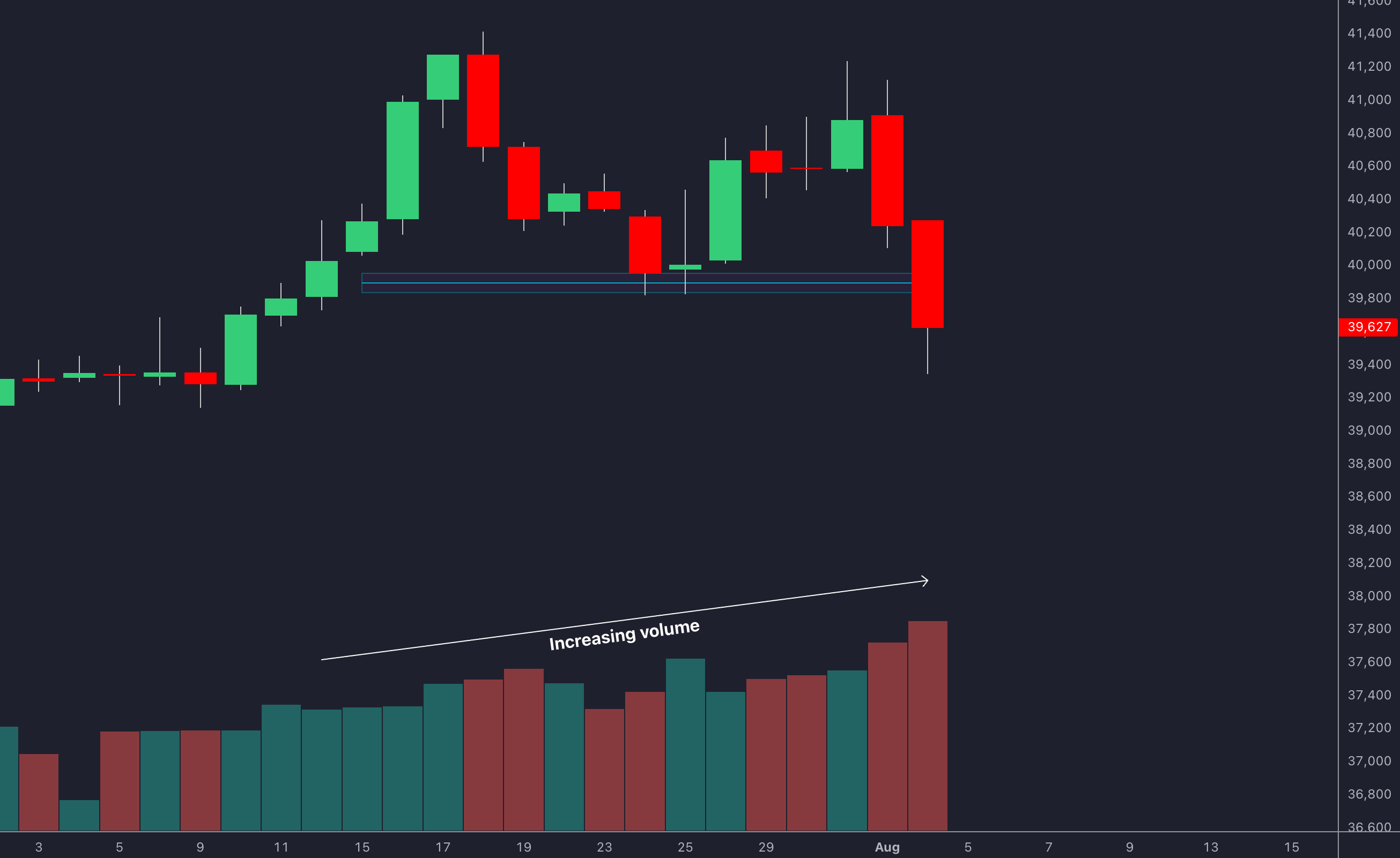Understanding how volume impacts support and resistance levels enhances trading strategies and improves decision-making.
Volume is key to understanding support and resistance in trading. High volume strengthens these levels, while low volume makes them weaker. Here's what you need to know:
- Support Levels: High volume shows strong buying interest, preventing price drops. Low volume increases the chance of breakdowns.
- Resistance Levels: High volume indicates strong selling pressure, making it harder for prices to rise. Low volume suggests potential breakouts.
- Breakouts and Reversals: High volume confirms genuine breakouts, while low volume often signals false breakouts. Rising volume near support can hint at trend reversals.
- Risk Management: Use volume to adjust position sizes and stop-loss levels for better risk control.
Quick Tip: LuxAlgo offers a range of advanced technical indicators on TradingView that help analyze volume patterns and refine trading strategies. Combine volume with other indicators for smarter trading decisions.
How Volume Relates to Support and Resistance

Defining Support and Resistance Levels
Support and resistance levels represent zones of intense trading activity. These aren't random lines but areas where price movement tends to pause or reverse. Support levels occur when buying pressure outweighs selling pressure, preventing further price drops. On the other hand, resistance levels emerge where selling pressure dominates, making it challenging for prices to climb higher.
How Volume Influences Price Movements
Volume acts as a key indicator of market interest and conviction, especially near support and resistance levels. When trading volume spikes around these zones, it signals heightened market engagement, which can significantly influence price behavior.
For example, volume provides insight into market dynamics by reflecting trader sentiment. In a recent SPY ETF pullback, two consecutive high-volume bars appeared at a support zone. This indicated strong buying interest, effectively halting the price decline.
Here’s a breakdown of how different volume patterns impact price behavior at these key levels:
| Volume Characteristic | Effect on Support | Effect on Resistance |
|---|---|---|
| High Volume | Strengthens the support level, showing strong buying activity | Reinforces the resistance level, highlighting strong selling pressure |
| Low Volume | Suggests weaker support, increasing the chance of a breakdown | Indicates weaker resistance, creating opportunities for a breakout |
Recognizing these patterns helps traders anticipate price movements and improve their strategies.
Volume as a Measure of Strength
Volume patterns can also reveal the strength of support and resistance levels. Take Lennar Corporation (LEN) as an example. Repeated tests of a support level showed consistent high-volume activity, with the fourth test confirming the level's importance.
To assess the strength of these levels using volume:
- Track high trading activity: Pay attention to volume trends as prices approach support or resistance zones. This helps identify whether the level is likely to hold.
- Watch volume during tests: Observe how volume reacts when the price tests these levels. Strong volume can indicate whether the level will hold or break.
LuxAlgo’s advanced technical indicators simplify this process. By analyzing volume patterns across multiple timeframes, traders can gain a deeper understanding of support and resistance strength under varying market conditions.
This understanding sets the stage for using volume to confirm breakouts and reversals, which we’ll dive into next.
Using Volume to Confirm Breakouts and Reversals
High Volume and Breakout Confirmation
When breakouts occur with high trading volume, it often signals strong market conviction. To spot this, traders should compare the breakout volume to the average daily trading volume over the past 20 sessions. Ideally, the breakout volume should be at least 50% higher than this average.
LuxAlgo’s volume analysis on TradingView highlights significant volume spikes compared to historical data, helping traders differentiate between genuine breakouts and misleading signals.
Identifying False Breakouts with Volume
Volume is a key indicator of market commitment, especially when assessing breakouts. If a breakout occurs on low volume, it often suggests hesitation in the market, increasing the chances of a false breakout.
Here’s a quick breakdown of how volume patterns align with breakout scenarios:
| Volume Pattern | Breakout Indication | Trading Implication |
|---|---|---|
| 50%+ above average | Likely strong breakout | Consider entering a position |
| Near average | Momentum unclear | Wait for more confirmation |
| Below average | Possible false breakout | Proceed with caution |
Volume Changes in Trend Reversals
Volume shifts at critical price levels can often hint at upcoming trend reversals. For instance, during a downtrend, rising volume near support levels may indicate increasing buying interest, potentially reversing the trend.
Some key volume patterns to watch for include:
- Climactic volume: A sudden spike after a long trend, often signaling exhaustion.
- Declining volume: Weakening momentum during price moves.
- Volume divergence: When price hits new highs or lows but volume doesn’t follow suit.
"The more buying and selling that has occurred at a particular price level, the stronger the support or resistance level is likely to be." - Investopedia, Support and Resistance Basics [2]
For better accuracy, combine volume analysis with other technical tools and examine multiple timeframes. LuxAlgo’s trader sentiment insights on TradingView complement volume analysis by automatically highlighting divergences and tracking money flow patterns across different periods.
These volume insights are valuable for crafting trading strategies, which we’ll dive into next.
Strategies for Trading with Volume at Key Levels
Using Volume for Entry and Exit Points
Volume analysis can be a powerful method for timing trades around support and resistance levels. It helps you determine whether these levels are likely to hold or break based on market activity.
Here’s how to interpret common volume patterns and their potential signals:
| Volume Pattern at Level | Trading Signal | Suggested Action |
|---|---|---|
| Rising volume at support | Strong buying interest | Consider taking a long position |
| Declining volume at resistance | Weak selling pressure | Hold your current positions |
| High volume rejection (sharp reversal) | Strong level confirmation | Enter a counter-trend trade |
| Low volume test | Weak interaction with level | Wait for stronger confirmation |
LuxAlgo’s Price Action Concepts on TradingView can help identify these volume clusters, making it easier to spot high-probability entry points.
Managing Risk with Volume Insights
Volume data isn’t just for spotting entries and exits – it’s also key to managing risk. Here’s how you can use it to protect your capital:
- Adjust position size and stop-loss levels based on volume strength: For high-volume trends, consider wider stop-loss levels and larger positions. For low-volume periods, use tighter stops and smaller positions.
- Rely on volume confirmation before increasing position size: This ensures you're not adding risk without sufficient backing from market activity.
By incorporating volume into your risk management plan, you can better safeguard your trades while still capitalizing on strong opportunities.
Combining Volume with Other Tools
Pairing volume analysis with additional technical methods can provide a more complete picture of the market. For example, market structure analysis can validate volume signals and offer further context.
"Volume acts as a confirming factor in technical analysis. It is used to confirm price movements by indicating the strength of a trend." - Faster Capital [1]
To get the most out of volume analysis, combine it with these methods:
- Use trend lines and moving averages to validate volume signals.
- Apply market structure analysis to understand the context of volume patterns.
- Incorporate price action patterns to fine-tune your trade entries.
Avoiding Mistakes in Volume-Based Analysis
When using volume to analyze support and resistance levels, traders can sometimes make errors that impact their decisions. Let’s take a closer look at how to sidestep these pitfalls.
Overemphasizing Volume Spikes
Volume spikes can be useful, but their context is crucial. Misreading them can lead to flawed conclusions. Here’s how to interpret these situations:
| Volume Spike Context | Possible Meaning | Recommended Action |
|---|---|---|
| News-Driven Spike | A short-term reaction, not necessarily a trend signal | Wait for the market to settle before acting |
| End of Day Spike | Routine activity tied to market closing | Avoid reading too much into it |
| Repeated Spikes at a Level | Indicates strong support/resistance | Use this alongside other indicators for better decisions |
Misinterpreting Low-Volume Areas
Low-volume zones can be just as telling as high-volume ones. These areas often suggest stability around key support or resistance levels.
"Misinterpreting volume can result in poorly timed trades, leading to losses or missed opportunities." - Nomad, Author at Coinmonks [1]
When dealing with low-volume areas, keep these points in mind:
- Market Structure: Low volume near established levels often signals that the market agrees on those price points.
- Trading Sessions: Some periods naturally see lower activity, such as early hours or specific global sessions.
- Historical Context: Look at how volume behaved at similar price levels in the past to spot patterns.
Tailoring Volume Analysis to Your Timeframe
Volume analysis isn’t one-size-fits-all. It should align with your trading style and timeframe. LuxAlgo’s volume analysis on TradingView can help you fine-tune your approach automatically.
| Timeframe | Volume Behavior to Watch | Primary Focus |
|---|---|---|
| Intraday | Quick, sharp changes in volume | Immediate shifts and reactions |
| Swing Trading | Weekly volume trends | Identifying short-term patterns |
| Position Trading | Broader monthly averages | Spotting long-term divergences |
Conclusion: Using Volume for Better Trading
Key Takeaways
Analyzing volume is a crucial step in confirming the reliability of support and resistance levels. When there’s noticeable volume around these levels, it reinforces their importance, helping traders make smarter decisions. Different volume patterns can signal trading opportunities, but these depend on the market environment and timeframe.
Here’s how you can put these ideas into action.
Practical Steps for Traders
Using advanced indicators can refine your volume-based strategies. LuxAlgo’s Volume Analysis on TradingView provides detailed volume profiling to pinpoint levels more accurately. It also comes with educational materials and community support to help traders improve their skills.
"Almost every successful day trader has a system they're confident in, and most (if not all) of those systems incorporate a volume indicator of some sort." - Lincoln Olson, Head of Content [1]
To make the most of volume-based strategies:
- Watch for volume clusters at key price points and confirm breakouts with matching volume increases.
- Compare current volume activity with historical trends to get the full picture.
- Pair volume analysis with other technical indicators to create a well-rounded trading strategy.


